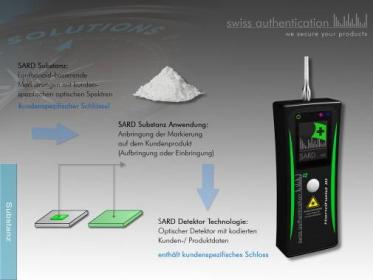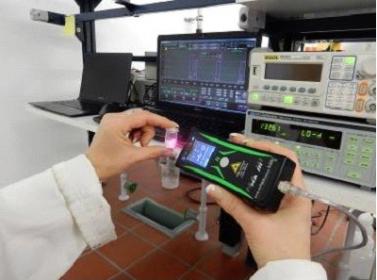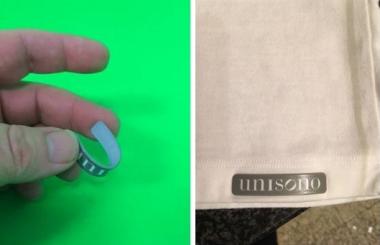DURABLE LABELING WITH LANTHANIDE-BASED SECURITY SUBSTANCE
- Forgery-safe Branded Fashion via washable Authentification Certificate
In 2014 German customs seized about 1.3 million counterfeit garments and accessories worth EUR 10.94 million. Particularly renowned brands suffer from piracy and try using different measures, such as hologram labels or special sewing yarns to protect their fashion - so far with little success, because professional counterfeiters can copy these marks most convincing.
But that could change now: As the first brand apparel manufacturer the Swiss wederundgut ag recently added on their UNiSONO -Shirts a labeling with a lanthanide-based SARD - safety substance which is completely tamper-proof due to high-covalent and doped crystal lattice. It has a unique, tailored composition with individual emission spectra and can be detected and deciphered only with an especially for this application developed laser measuring instrument. The incorporation in a multi-layer, firmly with the shirt fabric glued label, the marking cannot be destroyed neither by the wash liquor nor by mechanical influences during the washing process.
"Brand counterfeiting is becoming more and more a problem for the fashion industry. Especially well-known brands are suffering from the proliferation of plagiarism" Ueli Fish, CEO of wederundgut ag, explains. "It is therefore in our own interest as textile manufacturers, to find ways to make our products clearly marked as identifiable originals."
Within the sector many protective measures have already been tried, but without achieving a long term desired effect: One company for example works with holograms on the label. For professional plagiarists a hologram provides no bigger hurdle in these days, stated Dieter Ebert, CTO at the product protection specialist swiss authentication research and development AG (SARD) explains. As another possibility sewing threads will be soaked with safety fluids. "The disadvantage is that all known substances will sooner or later be completely washed out of the fabric in the washing process," the expert said. Several manufacturers of high-quality functional wear labeled their products temporarily with RFID chips. However, they also were destroyed in the washing process sooner or later - partly through the water, partially mechanically, so that this solution has been abandoned. Others prefer to educate their customers trying to explain differences between original and copied patches.
Individual, clearly identifiable marking
For the marking with the by SARD developed safety substance wederundgut ag decided due to the utter counterfeit security and adaptability for different applications. "The substance contains a custom mixture of lanthanides, which form a very complex, high-covalent and doped crystal lattice," the CTO explains. "In the production of a patented process at a defined point some foreign substances in the smallest amounts will be added that changes the emission spectrum significantly." By excitation in the UV or IR range the substance sends the customized optical spectra. These are stored in an associated detector, which has been developed by SARD for this application, and can only be recognized by the latter. All mixtures of the substance are stable at temperatures far above 1,700°C, resistant to acids, bases and radiation, highly resistant to chemicals and toxicologically safe. The particles, which generally have a size of about 1 to 10 microns, also allow no interactions with any other substances.
A decisive advantage of the substance is that the production process is not possible to replicate due to the artificial emission spectra: "Through the endowment spectra will be generated, of which it cannot be determined which elements are involved. Therefor a replica of the substance through reverse engineering is not possible, Ebert says.
Also the laser measuring device cannot be manipulated, since it has its own software and a virus free operating system and uses for algorithm and cryptography the FPGA technology. When evaluating the marking SARD also focuses on the key-lock principle: "The two independent emission spectra of custom substances serve as the key. They are stimulated and measured by the two independent laser systems of the detector”, so the CTO. “Decoding is performed with in the device stored, cryptographically encrypted information. They therefore act as a lock." Only when the correct substance is detected, a protected algorithm shows the customer-specific information on the display of the detector. This feature ensures a highly secure authentication.
Not leachable substance
In addition to the protection against forgery wederundgut is demanding further properties on the marking. "The label should not get an optically negative change, should be completely hypoallergenic and should remain from the cost point on an acceptable level," Fish says. The most important point for the textile manufacturer however was, that even after repeated washing the substance remains detectable: "That was at first a great challenge for us," Ebert says. "If we would have brought he SARD-substance in a conventional manner into the material, for example just with a color - as with solutions of other manufacturers - then there would have been the risk that the substance would be washed out by the surfactants of the detergent. Therefore we had to find at first a suitable carrier material. Together with the Munich label specialists RATHGEBER GmbH & Co. KG SARD finally developed a solution in which the substance will be incorporated into an iron-on label made of plastic composite material from which it cannot be removed. "This label is produced in several layers," Ebert says. "In one of them the SARD-substance will be incorporated and permanently sealed with another layer."
The label corresponds optically with the known company label of UNiSONO, the safety substance is difficult to detect with the bare eye. The final label is, among other things, resistant to alkalis, chemical cleaning agents, UV radiation, mechanical stress, acids, weather influences and keeps temperatures from -30 to 120°C. It will be ironed onto the shirt using a special hot-melt adhesive. This agent is very resistant and does not dissolve from the fabric, even at very frequent washing as is common for example in sports clothing. "At this project together with SARD we achieved great results very fast. With the current result, a very uncomplicated solution for us, we are very satisfied,” Fish explains, who puts the security label directly in the clothing factory on the shirts. “In the future we'd like to get a label that is even more soft and thinner than the current one. We intend to work on it together with SARD," the CEO said.
SARD






